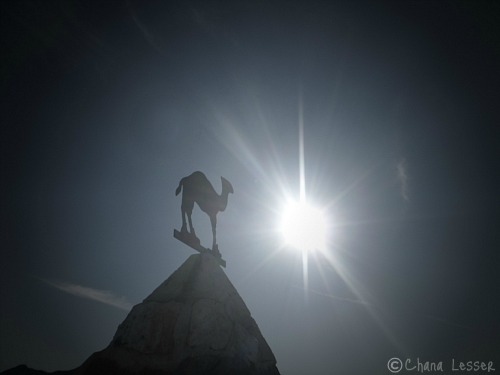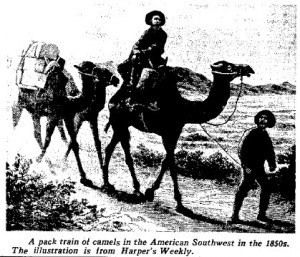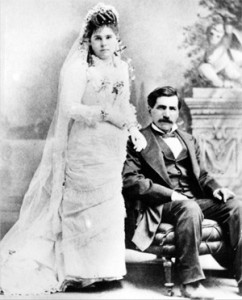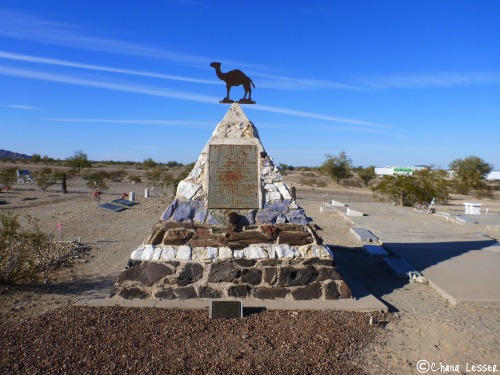A camel in the desert: The Legend of Hi Jolly
12 Feb
Back when Arizona was just another part of the New Mexican territory, before the surrender of Geronimo, the gun fight at the OK Corral and all the other things that really made Arizona famous – there were camels. Yes camels, those giant, spitting, hump-backed, two-toed beasts of burden trekked their way from Texas through Arizona all the way to California as members of the US Camel Corps. A project trumpeted by Senator Jefferson Davis as a sensible way to improve transportation in the southwest. Later, he would become famously known as the President of the short-lived Confederate States of America.
The camels used in this project came from different areas of the middle eastern region. Along with them came eight handlers, only two of which, had any real experience dealing with camels. The head camel driver was a short and stout man with a large black mustache. His name was Hadji Ali, a name given to him after his conversion to Islam and pilgrimage to Mecca. Not much is known about Ali’s beginnings or his original name, although many have speculated over the years. Some say he came from Syria; others
his arrival, Hadji Ali was renamed Hi Jolly by US soldiers, and the name would stick for the rest of his life.
From the beginning, the experiment had no shortage of problems. It took nearly two years just to train the camels who were also known to eat the prickly pear fencing they were kept in. US soldiers had a tough time learning how to ride and pack their camels properly. When the caravan finally hit the road, teamsters had to ride ahead of the group to warn people to keep any animals, such as horses or mules, hidden from sight as the mere presence of a camel tended to send them into a panic. The animal’s frenzy sometimes led to confrontations with ranchers, that ended with the camels exercising their famous spitting techniques. This only escalated the problem and in those days that meant – shotguns.
In general most people were unhappy with the “ships of the desert”. Their walk was more like a casual strut or sway, and after a long day riding could lead to wretched nausea from the human members of the Camel Corps. Their smell was far worse than that of a horse, and their feet couldn’t take the rocky terrain of the American Southwest, causing a host of other issues. The citizens of California wanted the steam engine; Nevada passed a law forbidding camels and even Native Americans were said to believe that evil spirits hibernated in the camel’s humps.
All along, Hi Jolly loved and cared for his camels. They had come to America together, and were probably the only thing he had to remind him of the home he would never see again. Eventually, the advent of the transcontinental railroad and the onset of the Civil War would bring the Camel Corps experiment to an end. It was deemed a failure, and the camels were either separated and sold off or released into the desert to fend for themselves. Hi Jolly purchased some of them and attempted to start his own shipping company. When that too failed, he tried his hand at gold-prospecting, army scouting and even became a mule-skinner for some time.
He finally became a US citizen in 1880 at the age of 52 and took a bride by the name of Gertrudis Serna from Tucson. They had two daughters but after less than 10 years of marriage they had drifted apart. Hi Jolly, now legally known as Philip Tedro, returned to gold prospecting and ended up living in Quartzite, AZ.
One dusty night in the saloon an old prospector ran through the swinging doors screaming “CAMELS! The camels are a-comin’ “. Still shaking the man took a few swigs from an unattended bottle at the bar. The bartender grabbed it back from his calloused hand – non too pleased. He was then invited for a drink and to tell his tale by other local patrons. As he launched into what he seemed to think was a near-death experience another quiet elderly prospector interrupted him. “Pard, would ye recollect about whar ye seed that camel?” With fervor the frightened prospector gave the best directions he could as he re-launched into his story for all who would listen and the other prospector quietly slipped out the door.
That quiet elderly prospector was in fact Hi Jolly himself, and few days later he was found in the desert; covered in sand.
“There was a frozen smile on his face…And his arms were locked about the neck of a great shaggy camel that, too, would tread the burning sands no more. Some insist the camel was smiling also, although it must have been a more toothy grin”.
-Monument to A Cameleer (The AZ Republic 4/14/57)
Today Hi Jolly is honored by a monument in Quartzite. A pyramid shaped structure with a tin camel on top and surrounded by his peers.
Special thanks to the staff at “The Arizona Room” in the Burton Barr Central Library for letting me rifle through their files.












 Facebook
Facebook Twitter
Twitter Flickr
Flickr Youtube
Youtube
You had shared such a nice true story with us. I like it. Thanks for sharing and given knowledge about “Hi Jolly’s Monument”.
Hey, Hi Jolly’s monument looks nice. I was not at all aware of this historical information. Thanks for the share.